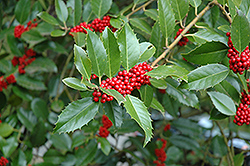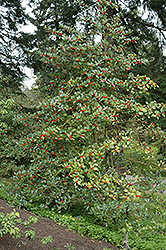VVF Plant Finder:
Height: 20 feet
Spread: 15 feet
Sunlight:
![]()
![]()
Hardiness Zone: 6b
Other Names: Koehne Holly
Description:
Large leaved holly useful in more spacious landscapes; a delightful ornamental plant with splendid rich, dark green, glossy leaves; abundant red fruit in winter
Ornamental Features
Chestnut Leaf Holly is primarily grown for its highly ornamental fruit. It features an abundance of magnificent red berries in late fall. It has attractive dark green evergreen foliage. The large serrated oval leaves are highly ornamental and remain dark green throughout the winter.
Landscape Attributes
Chestnut Leaf Holly is a dense multi-stemmed evergreen tree with a distinctive and refined pyramidal form. Its relatively coarse texture can be used to stand it apart from other landscape plants with finer foliage.
This is a relatively low maintenance tree, and is best pruned in late winter once the threat of extreme cold has passed. It is a good choice for attracting birds and bees to your yard. It has no significant negative characteristics.
Chestnut Leaf Holly is recommended for the following landscape applications;
- Mass Planting
- Hedges/Screening
- Naturalizing And Woodland Gardens
Planting & Growing
Chestnut Leaf Holly will grow to be about 20 feet tall at maturity, with a spread of 15 feet. It has a low canopy with a typical clearance of 1 foot from the ground, and is suitable for planting under power lines. It grows at a medium rate, and under ideal conditions can be expected to live for 50 years or more.
This tree does best in full sun to partial shade. It prefers to grow in moist to wet soil, and will even tolerate some standing water. It is particular about its soil conditions, with a strong preference for rich, acidic soils. It is quite intolerant of urban pollution, therefore inner city or urban streetside plantings are best avoided, and will benefit from being planted in a relatively sheltered location. Consider applying a thick mulch around the root zone in winter to protect it in exposed locations or colder microclimates. This particular variety is an interspecific hybrid.



